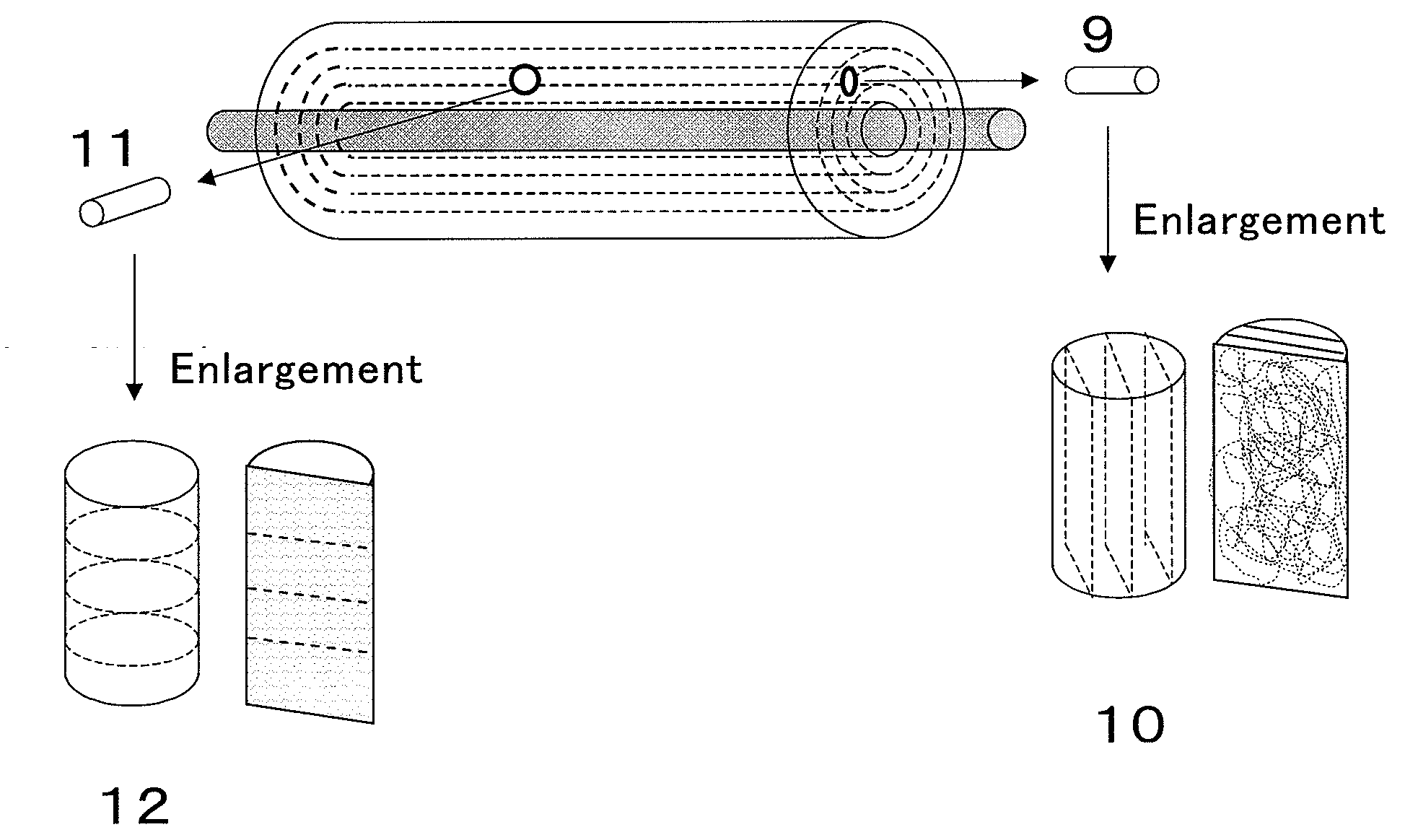Scaffold
- Summary
- Abstract
- Description
- Claims
- Application Information
AI Technical Summary
Benefits of technology
Problems solved by technology
Method used
Image
Examples
example 1
Preparation of Dope
[0087]A lactic acid-glycolic acid copolymer (molar ratio=50 / 50) was dissolved in a mixed solvent of methylene chloride and ethanol to prepare a 15 wt % dope.
(Spinning)
[0088]A cylindrical roll composed of an assembly of fibers was obtained by the electrospinning method using the apparatus shown in FIG. 4. The inner diameter of the nozzle (1) was 1.3 mm. The distance from the nozzle (1) to the winder (7) was 20 cm, and the distance from the nozzle (1) to the static electricity removing apparatus (8) was 35 cm. Applied voltage was 15 kV. The winder (7) and the static electricity removing apparatus (8) manufactured by Kasuga Denki Co., Ltd. were installed between the nozzle (1) and the negative electrode (5). The positive electrode (4) was inserted into the dope holding tank (3). The revolution of the winder (7) was set to 100 rpm.
[0089]The dope was fed to the dope holding tank (3), the distance between the nozzle (1) and the negative electrode (5) was adjusted, and f...
example 2
Preparation of Dope
[0096]The same lactic acid-glycolic acid copolymer as in Example 1 was used to prepare a 10 wt % dope.
(Spinning)
[0097]A cylindrical roll composed of an assembly of fibers was obtained in the same manner as in Example 1 except that the delivery time was set to 90 minutes and the heat treatment was carried out at 70° C. for 10 minutes.
(Cutting Out)
[0098]A cylindrical scaffold having a diameter of 5 mm and a height of 5 mm corresponding to 10 in FIG. 5 was cut out from the obtained roll in the same manner as in Example 1. FIG. 6 (top end face) and FIG. 7 (bottom end face) show microphotographs (15 magnifications) of a section parallel to the end faces of the scaffold corresponding to 10 in FIG. 5. It is seen that the fibers were accumulated in layers.
(Evaluation of Characteristic Properties)
[0099]The characteristics properties of the scaffold were evaluated in the same manner as in Example 1. The results are shown in Table 1.
(Biological Evaluation of Scaffold)
(Prepar...
example 3
Manufacture of Scaffold
[0106]The operation of Example 2 was repeated to obtain a cylindrical scaffold having a diameter of 5 mm and a height of 5 mm corresponding to 12 in FIG. 5. The measurement results of the characteristic properties of the scaffold are shown in Table 1.
[0107]FIG. 10 shows a photomicrograph (200 magnifications) of a section perpendicular to the end surface of the scaffold corresponding to 12 in FIG. 5. It is seen that the fibers are aligned in a plane direction. FIG. 11 (top end surface) and FIG. 12 (bottom end surface) show photomicrographs (15 magnifications) of a section parallel to the end faces of the scaffold corresponding to (12) in FIG. 5. It is seen that the fibers are accumulated densely like the mesh of a net.
[0108]A cell was cultured in the same manner as in Example 2 except that the obtained scaffold was used to measure the amount of DNA. The result is shown in Table 2. FIG. 13 and FIG. 14 show photomicrographs of the stained s...
PUM
| Property | Measurement | Unit |
|---|---|---|
| Diameter | aaaaa | aaaaa |
| Density | aaaaa | aaaaa |
| Area | aaaaa | aaaaa |
Abstract
Description
Claims
Application Information
 Login to View More
Login to View More - R&D
- Intellectual Property
- Life Sciences
- Materials
- Tech Scout
- Unparalleled Data Quality
- Higher Quality Content
- 60% Fewer Hallucinations
Browse by: Latest US Patents, China's latest patents, Technical Efficacy Thesaurus, Application Domain, Technology Topic, Popular Technical Reports.
© 2025 PatSnap. All rights reserved.Legal|Privacy policy|Modern Slavery Act Transparency Statement|Sitemap|About US| Contact US: help@patsnap.com



